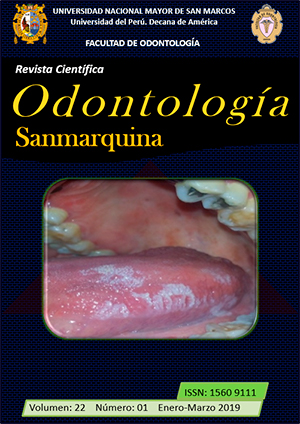Oral cavity injuries in patients with HIV in a state in southern Mexico
DOI:
https://doi.org/10.15381/os.v22i1.15857Keywords:
HIV infections; Oral candidiasis, Oral leukoplakia, Gingivitis; Mexico.Abstract
Objective: To determine the frequency of lesions of the oral cavity in people with HIV who are treated in the medical unit "Ambulatory Center for the prevention and care in AIDS and Sexually Transmitted Infections" (CAPASITS) of the city of Tuxtla Gutiérrez, Chiapas; Mexico. Methods: An observational, cross-sectional and prospective study was conducted in patients with a recent diagnosis of HIV, which included oral clinical review. Results: We included 58 patients diagnosed with HIV infection who were attended in the center in the period from June 2016 to March 2017, 75.9% were men, with an average of 31.6 years, 55.2% of them admitted heterosexuality and a primary level education (42.9%). The group of oral pathologies most frequently found were mycotic (89.7%), followed by bacterial (72.4%) and viral (65.5%), the most frequent lesions were pseudomembranous candidiasis (98.1%), hairy leukoplakia (60.3%) and gingival erythema (56.9%). Conclusions: 77.6% of the patients presented from two to four lesions, so that lesions in the oral cavity can be indicative of the level of the immune status of an individual, therefore, the dentist may be the first health professional to suspect the presence of HIV infection.
Downloads
Downloads
Published
Issue
Section
License
Copyright (c) 2019 Juan Carlos Nájera-Ortiz, Josymar Chorley-Sánchez

This work is licensed under a Creative Commons Attribution-NonCommercial-ShareAlike 4.0 International License.
AUTHORS RETAIN THEIR RIGHTS:
a. Authors retain their trade mark rights and patent, and also on any process or procedure described in the article.
b. Authors retain their right to share, copy, distribute, perform and publicly communicate their article (eg, to place their article in an institutional repository or publish it in a book), with an acknowledgment of its initial publication in the Odontología Sanmarquina.
c. Authors retain theirs right to make a subsequent publication of their work, to use the article or any part thereof (eg a compilation of his papers, lecture notes, thesis, or a book), always indicating the source of publication (the originator of the work, journal, volume, number and date).






